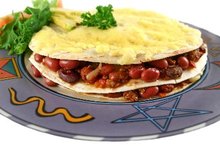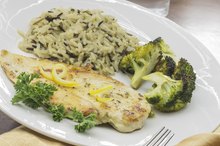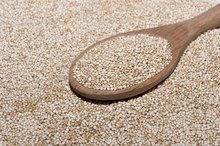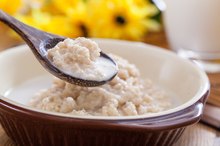Micro & Macro Nutrients in Bread
Bread has been called the “staff of life,” and the title is well-deserved. Even though some nutrient levels vary depending on the type of flour used, bread stands as a mainstay of the daily diet. The most basic white and whole-wheat breads, without additional ingredients such as oats or wheat germ, deliver the macronutrients and most of the micronutrients needed to sustain healthy functioning.
Macronutrient Overview
Nutrients that contribute energy, or calories, are called macronutrients. The three macronutrients are carbohydrates, protein and fat. Carbohydrates and protein provide four calories per gram, while fat supplies nine per gram. Carbohydrates are the body’s first choice for energy. Except for dietary fiber that is not digested, carbohydrates are quickly absorbed and broken down into glucose. Dietary fats are also needed by the body for growth and development, energy, healthy cell membranes and absorbing fat-soluble vitamins.
- Nutrients that contribute energy, or calories, are called macronutrients.
- Except for dietary fiber that is not digested, carbohydrates are quickly absorbed and broken down into glucose.
Micronutrient Overview
What Happens to Sugar Levels in the Blood While Fasting?
Learn More
The micronutrients are only needed in small amounts, but they're still essential. They do not provide energy, but some, especially the B vitamins, are an important part of the chemical processes that produce energy. This category includes all the vitamins and minerals. Vitamins A, D, E and K are fat-soluble, while the B vitamins and vitamin C are water-soluble. Minerals such as:
- calcium
- iron
- magnesium
- phosphorus
- potassium
- sodium
- zinc
- copper
- manganese
- selenium must all be obtained through dietary sources
Vitamins and minerals participate in too many different roles to list.
- The micronutrients are only needed in small amounts, but they're still essential.
- Vitamins A, D, E and K are fat-soluble, while the B vitamins and vitamin C are water-soluble.
Macronutrients in Bread
One slice of bread, weighing 1 oz., has about 70 calories and 0.9 g of total fat. You’ll also get about 4 to 5 percent of the recommended daily value of carbohydrates and 4 to 7 percent of the daily value of protein based on a 2,000 calorie-a-day diet, according to the U.S. Department of Agriculture 1.
Minerals in Bread
Are Whole-Wheat Tortillas Healthy?
Learn More
Bread provides every essential dietary mineral. One slice delivers 16 percent of the daily value of selenium, which is a trace element needed for many biochemical reactions. It’s a great source of manganese, with 30 percent of the daily value. Manganese is the primary antioxidant in the energy-producing mitochondria inside each cell. It activates enzymes needed for the metabolism of carbohydrates, amino acids and cholesterol, and it supports the formation of cartilage in the bone, as well as collagen used for healing wounds.
- Bread provides every essential dietary mineral.
- One slice delivers 16 percent of the daily value of selenium, which is a trace element needed for many biochemical reactions.
Vitamins in Bread
Bread contains all of the B vitamins except vitamin B-12. One slice provides about 7 percent of thiamin and niacin, as well as 3 percent of riboflavin, folate and vitamin B-6. White bread does not contain any fat-soluble vitamins, but whole-wheat bread has small amounts of vitamins E and K.
Related Articles
References
- U.S. Department of Agriculture: Nutrient Database
- U.S. Department of Agriculture. Bread, whole-wheat, commercially prepared. FoodData Central. 2019.
- Ma Y, Olendzki BC, Wang J, et al. Single-Component Versus Multicomponent Dietary Goals for the Metabolic Syndrome: A Randomized Trial. Ann Intern Med. 2015;162(4):248-257. doi:10.7326/M14-0611
- Clark MJ, Slavin JL. The effect of Fiber on Satiety and Food Intake: A Systematic Review. J Am Coll Nutr. 2013;32(3):200-211. doi:10.1080/07315724.2013.791194
Writer Bio
Sandi Busch received a Bachelor of Arts in psychology, then pursued training in nursing and nutrition. She taught families to plan and prepare special diets, worked as a therapeutic support specialist, and now writes about her favorite topics – nutrition, food, families and parenting – for hospitals and trade magazines.









